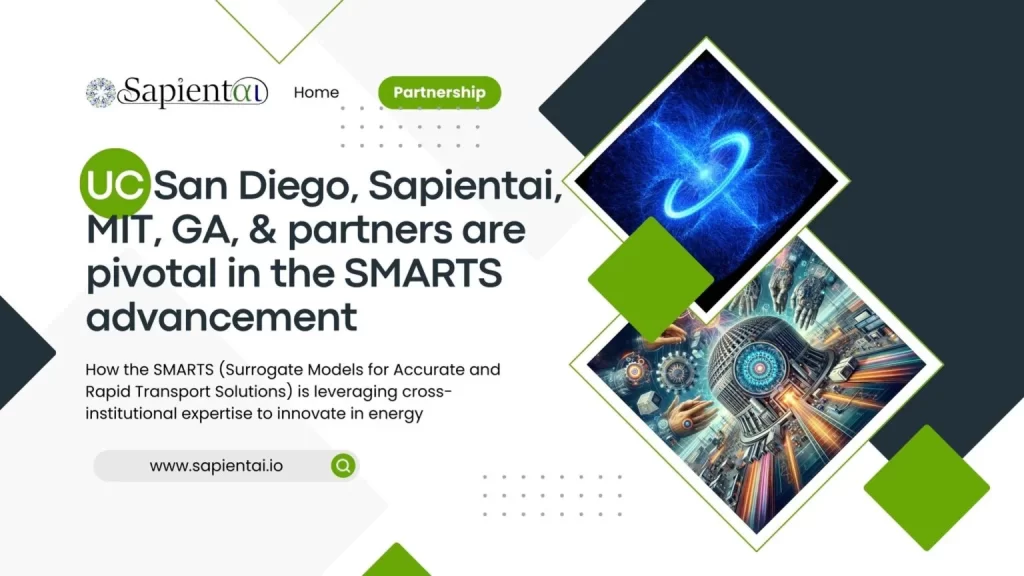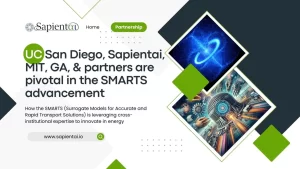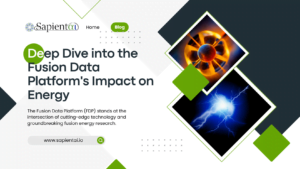(SMARTS) The pursuit of sustainable, economically viable fusion power has been a long-standing goal in the energy sector. The 2022 Bold Decadal Vision for Commercial Fusion Energy outlines a challenge to demonstrate a feasible path to fusion power that is economically attractive. Achieving this goal necessitates the development of cost-effective modeling and simulation tools capable of delivering accurate, timely, and actionable predictions, particularly in the context of designing and assessing a Fusion Pilot Plant (FPP). The FPP requires a comprehensive Whole Facility Modeling (WFM) capability to address numerous engineering challenges beyond just confining and sustaining a burning plasma.
The heart of an FPP’s design lies in accurately describing the burning plasma, the source of the heat and neutron fluxes that are transformed into electricity. The tokamak, a well-developed concept for confinement, has shown promising performance and predictive capabilities in plasma dynamics. However, the transition from current experimental setups to future burning plasmas brings significant uncertainties, especially regarding the plasma’s charged particle species densities. These densities, which include electrons, hydrogenic ions, helium ash from fusion reactions, and various impurities, are vital to the plasma’s behavior and performance. Their precise prediction at different locations within the plasma is key to optimizing FPP performance and is integral to a viable WFM capability.
The SMARTS (Surrogate Models for Accurate and Rapid Transport Solutions) project is designed to bridge the knowledge gap in predicting these particle and thermal confinements in tokamak burning plasmas. The project harnesses advancements in GPU acceleration of gyrokinetic codes, Bayesian optimization, and surrogate models for transport in fusion plasmas, integrated with tokamak modeling capabilities. A key outcome of SMARTS is the development of SMARTSsolver, a next-generation, open-source, high-performance computing (HPC)-compatible transport solver. This solver will support a hierarchy of transport model fidelities and employ surrogate models to provide precise and swift transport solutions, essential for practical WFM design and optimization.
Through SMARTS, we aim to solve specific challenges in fusion energy, such as predicting the behavior of plasmas under varying conditions and optimizing the design of fusion reactors for maximum efficiency and safety. SMARTSsolver will enable us to simulate and understand complex plasma phenomena that have been challenging to model accurately, paving the way for innovations in fusion energy research and development.
The SMARTS (Surrogate Models for Accurate and Rapid Transport Solutions) Overview
The SMARTS (Surrogate Models for Accurate and Rapid Transport Solutions) project is a multi-institutional initiative funded by the Department of Energy under the Scientific Discovery through Advanced Computing (SciDAC) program. This project aims to revolutionize the field of fusion energy by developing advanced predictive models for fusion reactor performance. By leveraging cutting-edge techniques from data science and machine learning, SMARTS seeks to enhance the accuracy and speed of these predictions, which are crucial for the efficient and reliable operation of fusion reactors.
At the heart of SMARTS is the development of surrogate models, sophisticated computational tools designed to simulate the complex processes within a fusion reactor. These models play a pivotal role in understanding and predicting the behavior of plasma, the hot, ionized gas at the core of fusion reactions. The project’s goals include improving the fidelity of these simulations, reducing computational time, and making fusion energy research more accessible to the scientific community.
SMARTS Key Participants and Their Roles
The SMARTS project, with its goal to revolutionize fusion reactor performance prediction, brings together a consortium of universities, industry leaders, and national laboratories. Each entity contributes unique expertise and resources, with Sapientai LLC playing a critical role in advancing the project’s AI and ML and ADA (Advanced Data Analytics) capabilities. This collaboration underscores the importance of interdisciplinary efforts in achieving breakthroughs in fusion energy research.
The key participants list includes :
- FASTMath SciDAC-5 Institute: This institute plays a crucial role in developing and deploying scalable mathematical algorithms and software tools for reliable simulation of complex physical phenomena. FASTMath collaborates with application scientists to ensure the usefulness and applicability of its technologies, focusing on developing robust mathematical techniques, numerical algorithms, and highly performant software.
- SciDAC Partnerships: The partnerships under SciDAC are integral to the program, enabling scientists to conduct complex scientific and engineering computations at a level of fidelity needed to simulate real-world conditions. These partnerships effectively link intellectual resources in applied mathematics and computer science, expertise in algorithms and methods, and scientific software tools at one or more SciDAC institutes.
- DOE Program Offices: The SciDAC program is co-funded by various Program Offices in the Office of Science (SC), including Basic Energy Sciences (BES), Biological and Environmental Research (BER), Fusion Energy Sciences (FES), High-Energy Physics (HEP), and Nuclear Physics (NP), along with the Office of Nuclear Energy (NE). These offices play a crucial role in exploiting leadership-class computing resources to advance scientific frontiers in areas of strategic importance.
The Consortium Participants
UC San Diego
UC San Diego leads the project management for SMARTS. Their responsibilities include developing the SMARTSsolver, creating reference scenarios, conducting near-edge profile modeling, and studying internal transport barriers (ITB) and burning plasma physics. They are also tasked with coordinating and collaborating with other SciDAC and FES programs, as well as focusing on workforce development and outreach.
MIT
MIT‘s involvement encompasses the development of SMARTSsolver, as well as contributing to PORTALS workflow and surrogate model studies. They are engaged in ion bundling density profile prediction and validation, and burning plasma physics studies. Additionally, MIT participates in workforce development and outreach initiatives.
General Atomics
General Atomics plays a significant role in the SMARTSsolver development and integrates it with STEP and OMFIT. Their responsibilities also include ion bundling density profile prediction and validation, ITB, and burning plasma physics studies. They contribute to the coordination and collaboration with other SciDAC and FES programs.
Sapientai LLC
Sapientai is responsible for the development and integration of the MGKDB with SMARTSsolver, OMFIT, and IPS. They participate in PORTALS workflow and surrogate model studies and engage in Internal Transport Barriers (ITB) physics studies.
Kalling Software
Kalling Software‘s contribution is focused on the development of OMFIT infrastructure to support both SMARTSsolver and MGKDB.
ORNL (Oak Ridge National Laboratory)
ORNL is involved in the development of SMARTSsolver and PORTALS workflow and surrogate model studies. They work on reference scenarios, MGKDB development, IPS infrastructure and integration, near-edge profile modeling, and burning plasma physics studies. Their role also includes coordination and collaboration with other SciDAC and FES programs, as well as workforce development and outreach.
SNL (Sandia National Laboratories)
SNL is tasked with the implementation and application of uncertainty quantification (UQ) tools and methodologies. They also focus on workforce development and outreach.
LBNL (Lawrence Berkeley National Laboratory)
LBNL‘s role involves the development and integration of MGKDB with SMARTSsolver, OMFIT, and IPS.
Solving Key Challenges with SMARTS: Real-World Examples
Optimizing Fusion Plant Performance
One of the central challenges in fusion energy is optimizing the performance of Fusion Pilot Plants (FPPs). SMARTS addresses this by improving our understanding of plasma behavior within tokamaks. For example, accurately predicting the densities of various charged particle species, such as electrons, ions, and helium ash, is crucial for optimizing the performance of FPPs. SMARTS enhances our ability to make these predictions, leading to more efficient and safer fusion reactors.
Improving Data Processing and Analysis
SMARTS can significantly improve the process of managing, curating, and analyzing large data sets in fusion research. By leveraging our ARPA-E Award-winning machine learning platform, we can process and interpret vast amounts of fusion data, leading to more informed decisions and strategies in FPP design and operation.
Supporting Sustainable Energy Goals
A core aspect of SMARTS is its contribution to the broader goal of sustainable energy. By resolving key issues in fusion energy, SMARTS paves the way for more viable and efficient fusion power solutions, aligning with global efforts to develop cleaner energy sources.
Driving Innovation in Energy Research
The predictive models developed through SMARTS have the potential to revolutionize energy research. By providing accurate predictions of plasma behavior, SMARTS opens up new avenues for innovation in fusion energy, potentially accelerating the development of commercial fusion power.
Sapientai LLC: A Fusion of Expertise
Founded by a team of fusion scientists and computational experts, Sapientai LLC is a powerhouse in AI-driven solutions for fusion energy. Central to our efforts are the Ousai framework and the Archaieus Engine, providing robust and adaptable AI tools for fusion systems. Our strength lies in system identification capabilities, enabling the extraction of meaningful models from complex data sets.
Our Strategic Partnerships in Fusion
Our journey has been marked by remarkable collaborations, including partnerships with General Atomics, UCSD, HPE, and more. We have recently joined forces with these entities to develop a Fusion Data Platform, showcasing our commitment to collaborative innovation and sustainable energy solutions. Our SIR AI tool, a SOTA framework for advanced system discovery, is instrumental in understanding complex data from fusion devices like General Atomics’ DIII-D tokamak.
Sapientai’s Role in SMARTS
In SMARTS, Sapientai LLC’s involvement is pivotal. Our expertise in Advanced Data Analytics (ADA), Machine Learning (ML), and Artificial Intelligence (AI) solutions is crucial in enhancing the project’s predictive capabilities. By leveraging our advanced computational tools and collaborative spirit, we aid in making significant advancements toward practical fusion energy.
Expanding the Horizons: MLOps Services and Beyond
At Sapientai LLC, we offer more than just AI solutions; we provide a comprehensive suite of services including MLOps (Machine Learning Operations). Our MLOps services, coupled with the transformative capabilities of the SIR platform, are expected to be monumental in optimizing fusion data, capturing intricate patterns, and generating actionable insights. This not only addresses the industry’s most pressing challenges but also opens doors to new opportunities in fusion energy exploration.
Conclusion: Shaping the Future of Fusion Energy
The SMARTS (Surrogate Models for Accurate and Rapid Transport Solutions) project, a collaborative effort under the SciDAC program, aims to enhance our predictive understanding of burning plasma physics. By integrating advanced computational models and innovative simulation techniques, SMARTS is poised to offer significant contributions to both public and private fusion research endeavors.
This initiative, driven by a coalition of leading institutions and researchers, is expected to deliver new modeling and simulation capabilities that will advance our knowledge of plasma behavior in fusion reactors. Crucially, SMARTS is not just about enhancing technological capabilities; it is equally focused on nurturing the next generation of fusion researchers. The project emphasizes the importance of fostering a diverse, equitable, and inclusive research community, ensuring that the field of fusion research continues to grow and evolve with contributions from a wide range of perspectives and backgrounds.
As we step into the future, the work of the SMARTS team is set to play a vital role in the ongoing pursuit of sustainable and efficient fusion energy. The project’s focus on improving predictive capabilities for burning plasmas and its commitment to community-building mark an important milestone in the journey towards realizing the full potential of fusion as a clean energy source. Through SMARTS, the fusion research community is better equipped to tackle the challenges ahead, paving the way for advancements that will have a lasting impact on the field and beyond
FAQ
What is SMARTS?
SMARTS stands for Surrogate Models for Accurate and Rapid Transport Solutions. It’s a collaboration under the SciDAC-5 partnerships focused on enhancing the predictive modeling and simulation capabilities for tokamak burning plasmas, crucial for advancing fusion energy research.
Who are the key participants in the SMARTS project?
The SMARTS project is a collaborative effort between the Office of Fusion Energy Sciences and Advanced Scientific Computing Research at the US Department of Energy Office of Science. Key institutional partners include the University of California, San Diego, Sapientai, and others involved in computational and fusion energy sciences.
What are the main goals of the SMARTS project?
The primary goal is to provide validated modeling and simulation capabilities that enable accurate and computationally efficient predictions of multi-species particle and thermal confinement in tokamak burning plasmas. This involves combining advances in GPU acceleration of gyrokinetic codes, Bayesian optimization, surrogate models, and integrated tokamak modeling.
How is Sapientai contributing to the SMARTS project?
Sapientai is playing a critical role in leveraging AI and ML solutions to advance fusion energy research. Through projects like SMARTS, Sapientai aims to accelerate the path toward commercial fusion energy by applying machine learning and artificial intelligence in innovative ways.
What makes fusion energy significant?
Fusion energy offers the promise of a clean, virtually limitless source of power by replicating the processes that power the sun and stars. It has the potential to revolutionize how we generate electricity, offering a sustainable solution to future energy needs without contributing to climate change.
What are some challenges in achieving fusion energy?
Achieving controlled, sustainable fusion energy is highly challenging due to the extreme conditions required for fusion reactions to occur. These include incredibly high temperatures and pressures, maintaining plasma stability, and ensuring the process produces more energy than it consumes.





